Fangfang Zhou
Unleashing the Power of Self-Supervised Image Denoising: A Comprehensive Review
Aug 09, 2023Abstract:The advent of deep learning has brought a revolutionary transformation to image denoising techniques. However, the persistent challenge of acquiring noise-clean pairs for supervised methods in real-world scenarios remains formidable, necessitating the exploration of more practical self-supervised image denoising. This paper focuses on self-supervised image denoising methods that offer effective solutions to address this challenge. Our comprehensive review thoroughly analyzes the latest advancements in self-supervised image denoising approaches, categorizing them into three distinct classes: General methods, Blind Spot Network (BSN)-based methods, and Transformer-based methods. For each class, we provide a concise theoretical analysis along with their practical applications. To assess the effectiveness of these methods, we present both quantitative and qualitative experimental results on various datasets, utilizing classical algorithms as benchmarks. Additionally, we critically discuss the current limitations of these methods and propose promising directions for future research. By offering a detailed overview of recent developments in self-supervised image denoising, this review serves as an invaluable resource for researchers and practitioners in the field, facilitating a deeper understanding of this emerging domain and inspiring further advancements.
High Dynamic Range Imaging with Context-aware Transformer
Apr 21, 2023Abstract:Avoiding the introduction of ghosts when synthesising LDR images as high dynamic range (HDR) images is a challenging task. Convolutional neural networks (CNNs) are effective for HDR ghost removal in general, but are challenging to deal with the LDR images if there are large movements or oversaturation/undersaturation. Existing dual-branch methods combining CNN and Transformer omit part of the information from non-reference images, while the features extracted by the CNN-based branch are bound to the kernel size with small receptive field, which are detrimental to the deblurring and the recovery of oversaturated/undersaturated regions. In this paper, we propose a novel hierarchical dual Transformer method for ghost-free HDR (HDT-HDR) images generation, which extracts global features and local features simultaneously. First, we use a CNN-based head with spatial attention mechanisms to extract features from all the LDR images. Second, the LDR features are delivered to the Hierarchical Dual Transformer (HDT). In each Dual Transformer (DT), the global features are extracted by the window-based Transformer, while the local details are extracted using the channel attention mechanism with deformable CNNs. Finally, the ghost free HDR image is obtained by dimensional mapping on the HDT output. Abundant experiments demonstrate that our HDT-HDR achieves the state-of-the-art performance among existing HDR ghost removal methods.
MM-BSN: Self-Supervised Image Denoising for Real-World with Multi-Mask based on Blind-Spot Network
Apr 07, 2023Abstract:Recent advances in deep learning have been pushing image denoising techniques to a new level. In self-supervised image denoising, blind-spot network (BSN) is one of the most common methods. However, most of the existing BSN algorithms use a dot-based central mask, which is recognized as inefficient for images with large-scale spatially correlated noise. In this paper, we give the definition of large-noise and propose a multi-mask strategy using multiple convolutional kernels masked in different shapes to further break the noise spatial correlation. Furthermore, we propose a novel self-supervised image denoising method that combines the multi-mask strategy with BSN (MM-BSN). We show that different masks can cause significant performance differences, and the proposed MM-BSN can efficiently fuse the features extracted by multi-masked layers, while recovering the texture structures destroyed by multi-masking and information transmission. Our MM-BSN can be used to address the problem of large-noise denoising, which cannot be efficiently handled by other BSN methods. Extensive experiments on public real-world datasets demonstrate that the proposed MM-BSN achieves state-of-the-art performance among self-supervised and even unpaired image denoising methods for sRGB images denoising, without any labelling effort or prior knowledge. Code can be found in https://github.com/dannie125/MM-BSN.
Self-Supervised Image Denoising for Real-World Images with Context-aware Transformer
Apr 04, 2023Abstract:In recent years, the development of deep learning has been pushing image denoising to a new level. Among them, self-supervised denoising is increasingly popular because it does not require any prior knowledge. Most of the existing self-supervised methods are based on convolutional neural networks (CNN), which are restricted by the locality of the receptive field and would cause color shifts or textures loss. In this paper, we propose a novel Denoise Transformer for real-world image denoising, which is mainly constructed with Context-aware Denoise Transformer (CADT) units and Secondary Noise Extractor (SNE) block. CADT is designed as a dual-branch structure, where the global branch uses a window-based Transformer encoder to extract the global information, while the local branch focuses on the extraction of local features with small receptive field. By incorporating CADT as basic components, we build a hierarchical network to directly learn the noise distribution information through residual learning and obtain the first stage denoised output. Then, we design SNE in low computation for secondary global noise extraction. Finally the blind spots are collected from the Denoise Transformer output and reconstructed, forming the final denoised image. Extensive experiments on the real-world SIDD benchmark achieve 50.62/0.990 for PSNR/SSIM, which is competitive with the current state-of-the-art method and only 0.17/0.001 lower. Visual comparisons on public sRGB, Raw-RGB and greyscale datasets prove that our proposed Denoise Transformer has a competitive performance, especially on blurred textures and low-light images, without using additional knowledge, e.g., noise level or noise type, regarding the underlying unknown noise.
* 10 pages, 9 figures
ASTF: Visual Abstractions of Time-Varying Patterns in Radio Signals
Sep 30, 2022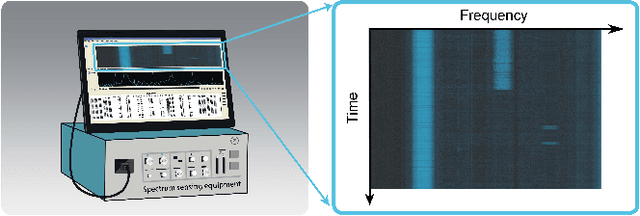

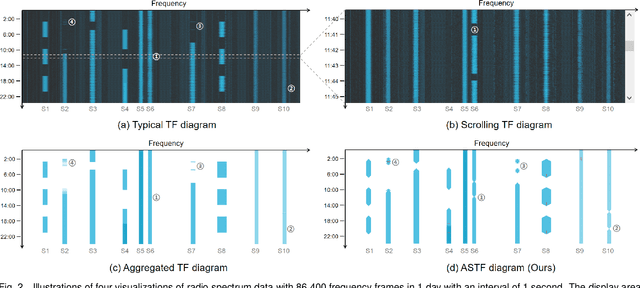
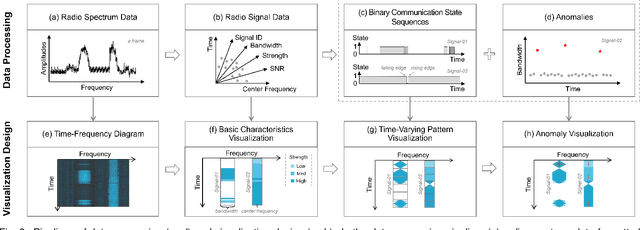
Abstract:A time-frequency diagram is a commonly used visualization for observing the time-frequency distribution of radio signals and analyzing their time-varying patterns of communication states in radio monitoring and management. While it excels when performing short-term signal analyses, it becomes inadaptable for long-term signal analyses because it cannot adequately depict signal time-varying patterns in a large time span on a space-limited screen. This research thus presents an abstract signal time-frequency (ASTF) diagram to address this problem. In the diagram design, a visual abstraction method is proposed to visually encode signal communication state changes in time slices. A time segmentation algorithm is proposed to divide a large time span into time slices.Three new quantified metrics and a loss function are defined to ensure the preservation of important time-varying information in the time segmentation. An algorithm performance experiment and a user study are conducted to evaluate the effectiveness of the diagram for long-term signal analyses.
Reverse-engineering Bar Charts Using Neural Networks
Sep 05, 2020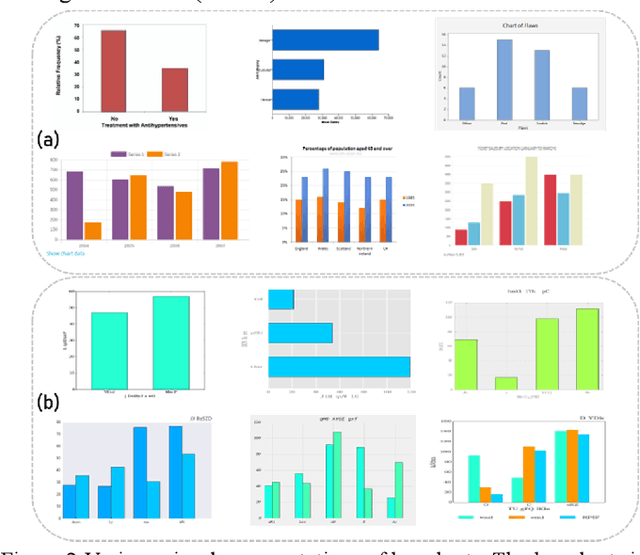
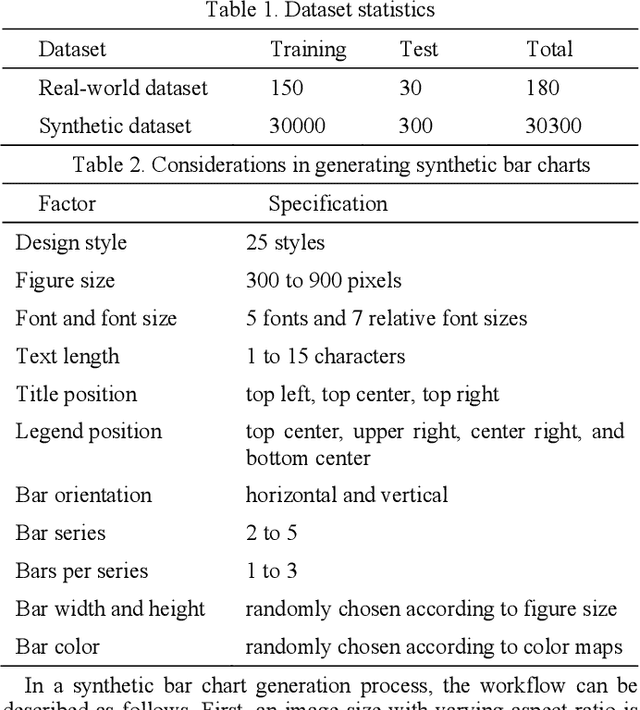


Abstract:Reverse-engineering bar charts extracts textual and numeric information from the visual representations of bar charts to support application scenarios that require the underlying information. In this paper, we propose a neural network-based method for reverse-engineering bar charts. We adopt a neural network-based object detection model to simultaneously localize and classify textual information. This approach improves the efficiency of textual information extraction. We design an encoder-decoder framework that integrates convolutional and recurrent neural networks to extract numeric information. We further introduce an attention mechanism into the framework to achieve high accuracy and robustness. Synthetic and real-world datasets are used to evaluate the effectiveness of the method. To the best of our knowledge, this work takes the lead in constructing a complete neural network-based method of reverse-engineering bar charts.
 Add to Chrome
Add to Chrome Add to Firefox
Add to Firefox Add to Edge
Add to Edge